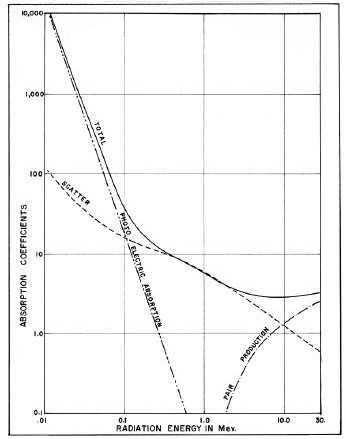T.O. 33B-1-1
6-39
the mass of an electron is equivalent in energy to a 0.51 MeV photon. This explains the requirements for a photon to
have energy of at least 1.02 MeV before pair production can occur. Additional energy above the 1.02 MeV causes the
pair of particles to have kinetic energy or velocity. The position may cause ionization or it may combine with an
electron, causing annihilation and emission of two gamma photons of 0.51 MeV per photon. These lower energy
photons may subsequently interact by either the photoelectric or Compton effect absorption modes.
6.5.1.4
Significance of Absorption Mechanisms.
With three different absorption mechanisms it is evident that an absorber, when bombarded by photons of
electromagnetic radiation, has absorption characteristics highly affected by photon energy. Figure 6-16 is a graph
illustrating the three major modes of absorption and how they contribute to the total absorption in the element iron with
its atomic number of 26. It should be noted from Figure 6-16 that nearly all of the absorption of radiation below 100
keV is due to the photoelectric effect. This absorption is highly dependent upon the atomic structure and the binding
energies between the electrons and the nucleus. Therefore, the atomic number of the material will greatly affect
radiation absorption by the photoelectric effect. When radiation energy is between 100 keV and about 10 MeV,
absorption is almost entirely due to Compton effect and atomic number is no longer the major criteria of absorption;
instead, material density is the major controlling factor. It should also be noted that in the energy range between 10
and 100 keV, radiation absorption is very sensitive to keV changes: a unit change in keV will cause three units of
change in the atomic absorption coefficient. For energies between 200 keV and about 3 MeV a unit change in keV will
only cause half a unit change in the atomic absorption coefficient, so the absorber is much less sensitive to changes in
radiation energy. When the radiation energy is between 3 and 30 MeV, the atomic absorption coefficient is for
practical purposes unchanged.
Figure 6-16. Absorption Coefficients for Different Modes of Absorption in Iron.


